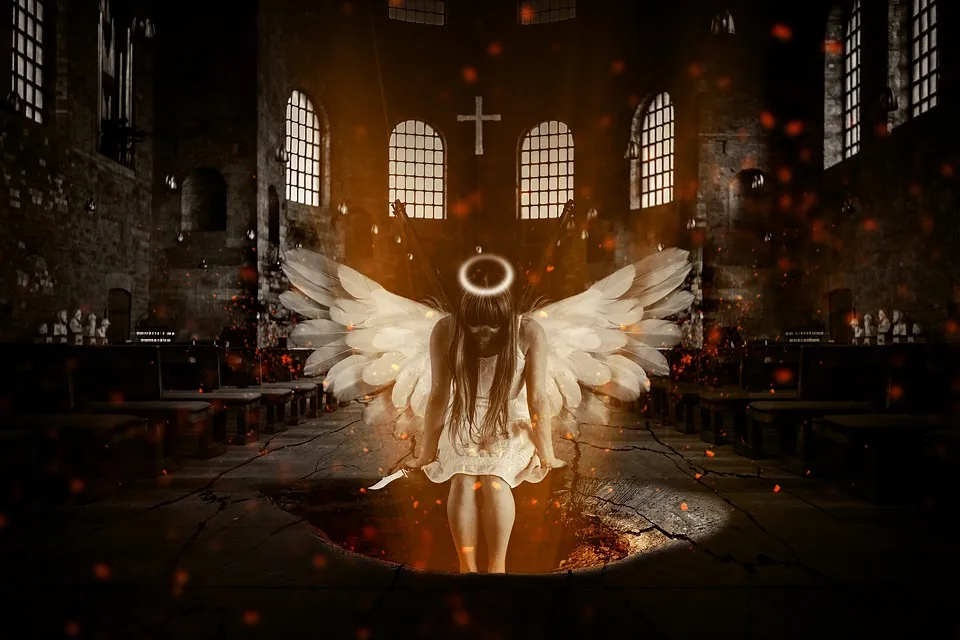Ever wondered if Satan was truly an angel? The topic has been a source of controversy among theologians and scholars for thousands of years. In this article, we’ll explore the origins of Satan’s fall from grace, delve into its biblical implications, and shed light on the story of Lucifer’s rebellion and much more. Join us on this journey of discovery as we explore the topic of was Satan an angel?
Angels – The Heavenly Hosts

Angels have long been a part of spiritual beliefs and religious texts. In many cultures, they are known as the messengers of god who carry out his will. In Christianity, angels are believed to be created by God before the creation of the world. They are described as celestial beings who dwell in heaven and serve as messengers, protectors, and guides to human beings.
One of the most well-known angels in Christian mythology is Lucifer, who was believed to be a high-ranking archangel before his fall from grace. According to the biblical account, Lucifer became proud and disobedient, desiring to be like God. As a result, he and his followers rebelled against God, leading to a great war in heaven.

The rebellion was ultimately quashed, and Lucifer and his followers were cast out of heaven and into hell, becoming the first demons. This event is commonly known as the angelic rebellion, and it is said to be the origin of evil in the world.
The story of Lucifer’s fall and his subsequent transformation into the devil is one of the most enduring and well-known tales of good and evil in religious text. It has been interpreted by scholars and theologians in various ways, and it has been the subject of countless artistic interpretations and works of literature.
At the heart of the mythos of Satan is the concept of disobedience and rebellion against God. Some interpretations describe Lucifer as a tragic figure who fell from grace due to his own hubris, while others portray him as a malevolent and devilish character. Regardless of the interpretation, Lucifer’s role as the embodiment of evil and the master of hell is a central tenet of Christian theology.
Demonology, the study of evil spirits, has long been a part of spiritual beliefs and practices around the world. In Christianity, demons are believed to be the fallen angels who followed Lucifer in his rebellion against God. They are often depicted as infernal ranks within the angelic hierarchy, with Lucifer at the top of the chain. The hellish underworld is said to be their domain, and they are known to tempt and torment human beings.
In conclusion, the story of Lucifer’s rebellion and fall from grace is one of the most enduring and well-known tales of good and evil in religious text. It has been interpreted in various ways over the centuries, but at its core, it speaks to the human urge to rebel against authority and seek power. The mythos of Satan and demonology continue to fascinate and inspire people around the world, making them a vital part of religious and cultural traditions.
- Angels are celestial beings created by God who dwell in heaven and serve as messengers, protectors, and guides to human beings.
- Lucifer is a high-ranking archangel who rebelled against God and was cast out of heaven, becoming the first demon.
- The angelic rebellion is the origin of evil in the world.
- The mythos of Satan and demonology continue to fascinate and inspire people around the world.
Lucifer – The First Sinner
The story of Lucifer, the archangel who fell from heaven and became the devil, is one of the most well-known tales in religious text. But was Satan really an angel? According to theological belief, yes. In fact, Lucifer was once one of the most prominent angels in the heavenly hierarchy.
Angels – The Heavenly Hosts
Angels are supernatural beings created by God who serve as messengers and protectors. In Christian mythology, angels are divided into different ranks within an angelic hierarchy. Archangels, like Lucifer, are the highest-ranking angels, followed by dominions, virtues, powers, principalities, thrones, cherubim, and seraphim.
Lucifer – The First Sinner
Lucifer, also known as the devil or Satan, was originally an archangel created by God as a guardian of the heavenly realms. However, according to biblical accounts, Lucifer became proud and rebellious, convinced that he was as powerful as God and deserving of worship himself. This pride led to his downfall, and he was cast out of heaven along with other angels who had sided with him in the angelic rebellion.
The Great Rebellion in Heaven
Lucifer’s rebellion, also known as the angelic rebellion, is talked about in the Bible and religious text. According to the Book of Revelation, a war broke out in heaven between Michael – the leader of God’s angels – and the devil and his fallen angels. The devil was defeated, and he and his followers were cast out of heaven and condemned to the fiery pits of hell.

The Fall of Satan and the Origin of Evil
The fall of Satan marked the beginning of evil in the world. According to Christian mythology, the devil was responsible for tempting Adam and Eve to disobey God, leading to their expulsion from the Garden of Eden. Satan has since been seen as a symbol of evil and the embodiment of all that is wicked in the world.
Satan’s Role in the Bible and Interpretation
Satan plays a significant role in the Bible, appearing as a character in many stories and serving as a symbol of temptation, evil, and sin. In biblical interpretation, the devil is often seen as a metaphor for the struggle between good and evil within humans and the world. Lucifer’s rebellion is also an important theological concept, used to explain the existence of sin and evil in the world.
Demonology – The Study of Evil Spirits
Demonology is the study of evil spirits, including demons like Satan and his fallen angels. Within demonology, there is a hierarchy of infernal ranks, with the devil at the top and demons of varying power and prominence below him. The study of demonology has been a popular subject in spiritual beliefs throughout history, with many cultures having their own mythos of Satan and evil spirits.
In summary, Lucifer was indeed an angel, one of the highest-ranking and most powerful among God’s heavenly hosts. His pride and rebellion led to his fall from grace and transformation into the devil. This transformation marked the origin of evil in the world and continues to play a significant role in theological interpretation and demonology.
The Great Rebellion in Heaven
Once, heaven was a perfect and harmonious place, filled with an uncountable amount of angels. Among these hosts of heaven was an archangel named Lucifer, a beautiful and powerful being known for his wisdom and splendor. But, as it happened, Lucifer never saw himself as simply another angel. He began to harbor the desire to be held in higher esteem than he was given, even though he was one of the highest-ranking angels in existence.
Little by little, Lucifer grew prideful, coveting the admiration that he felt he deserved. He eventually began to see himself as an equal to God and began to rebel against His authority. Lucifer’s rebellion took place in heaven, and he convinced a third of the angels to follow him.
« When Did Adam Pass Away? The Answers to the Lifespan of the Bible’s First Man
Ezekiel in the Bible: God’s Messenger and Divine Revelations »
Together, Lucifer and his followers challenged God’s authority and sought to set themselves up as rivals to the Almighty. Despite their considerable power, however, their rebellion was doomed to fail. God, in His infinite wisdom, saw the pride and rebellion in Lucifer’s heart, and he cast him and his rebellious angels out of heaven.
As a result of Lucifer and his followers’ disobedience, heaven and its inhabitants forever changed. Angels were split into two factions: those loyal to God and those who chose to follow Lucifer. God’s holy and perfect kingdom was forever tainted by Lucifer’s fall, and the great battle between good and evil began.
Even though Lucifer and his followers were expelled from heaven, they didn’t simply blink out of existence. Instead, they were cast into a hellish underworld, where they were transformed into demonic entities. Because of this, Lucifer became known as the devil and the leader of those who opposed God.
The great rebellion in heaven is a biblical account of Satan’s rebellion against God’s authority and the origin of evil that we face today. In the next section, we will explore Satan’s role in the Bible and the interpretations that have arisen from this mythos.

List of SEO Keywords:
- angelic rebellion
- biblical interpretation
- religious text
- theology
- fallen angel
- archangel lucifer
- divine punishment
- lucifer’s origin
- disobedience
- spiritual beliefs
- devil
- the devil’s fall
- good and evil
- devilish character
- lucifer’s role
- demonology
- infernal ranks
- lucifer’s downfall
- demon
- angelic hierarchy
- hellish underworld
- christian mythology
- evil spirits
- lucifer’s rebellion
- biblical account of Satan
- mythos of Satan
The Fall of Satan and the Origin of Evil
Satan, also known as the devil, is a prominent figure in many religious texts and spiritual beliefs. According to the Biblical account, Satan was not always a fallen angel, but was once a glorious and beautiful being known as Lucifer. However, Lucifer’s pride and disobedience led to his fall from grace and his transformation into the devil.
Lucifer was initially created by God as one of the most powerful and beautiful angels in heaven. He was the “shining one,” an archangel of great beauty and intelligence, and was positioned near God’s throne. But due to his pride and desire to be greater than God, Lucifer rebelled against God’s authority and led a third of the angels in a rebellion against God.
The Great Rebellion in Heaven
The Bible describes this rebellion as a great war in the heavenly realm. While it is not entirely clear what transpired during the rebellion, it is clear that Lucifer was the ringleader of this insurrection. He ultimately failed in his attempt to overthrow God and was cast out of heaven along with his followers.

The Fall of Satan and the Origin of Evil
Lucifer’s fall from grace resulted in his transformation into Satan, the accuser and adversary of God. This event marks the beginning of evil in the world, which Satan continues to spread to this day. Theologians and scholars have debated the meaning of Satan’s fall and his role in human suffering, but the general consensus is that Satan’s rebellion and subsequent punishment were a result of his disobedience and pride.
Satan’s Role in the Bible and Interpretation
The Bible portrays Satan as a cunning and deceitful character who seeks to tempt and destroy humanity. He is often depicted as a serpent in the Garden of Eden who tempted Eve to disobey God and eat the forbidden fruit. Satan also appears in various parables and teachings, always as a symbol of evil and temptation.
Theologians have debated the exact nature of Satan’s rebellion and punishment, as well as his role in human affairs. Some believe that Satan is a real being who actively seeks to harm humans, while others view him as a metaphor for the destructive forces of evil in the world.

Demonology – The Study of Evil Spirits
The study of evil spirits, also known as demonology, has been a topic of fascination for centuries. Some scholars focus on the hierarchy of demons and the infernal ranks, while others explore the mythos of Satan and his rebellion. Regardless of the approach, demonology seeks to understand the nature and role of evil in the world.
In conclusion, the fall of Satan and the origin of evil is a complex and controversial topic that has been widely debated for centuries. While there are various interpretations of Satan’s fall from grace, most agree that it was the result of his pride and disobedience. Satan continues to be a symbol of evil and temptation in religious texts and spiritual beliefs, and demonology seeks to understand the nature of evil in the world.
Satan’s Role in the Bible and Interpretation
Satan, also known as the devil or Lucifer, is one of the most notorious and feared figures in religious text and theology. In the Bible’s account of Satan, he is depicted as a fallen angel who rebelled against God and was cast out of heaven along with his followers. But was Satan really an angel? And what is his role in the Bible and religious beliefs?
-
Angels – The Heavenly Hosts
Before delving into the biblical accounts of Satan, it is important to first understand the nature of angels. Angels are heavenly beings created by God to serve as messengers and warriors. They exist to carry out the will of God and act as intermediaries between heaven and earth. -
Lucifer – The First Sinner
Lucifer, also known as the morning star, was an archangel created by God with great power and beauty. He was the ultimate representation of God’s glory and perfection. But Lucifer became prideful and disobedient, believing that he was greater than God himself. This arrogance led to his downfall and the transformation into the devil. -
The Great Rebellion in Heaven
Lucifer convinced a third of the angels to follow him in his rebellion against God. This led to a great war in heaven, which ended with Lucifer and his rebel angels being cast out of heaven and into hell. -
The Fall of Satan and the Origin of Evil
The fall of Satan marked the beginning of evil in the world. Satan became the embodiment of evil and temptation, tempting humans to sin and rebel against God. Satan is believed to have a great deal of power over the world, but his power is limited by God’s ultimate authority. -
Satan’s Role in the Bible and Interpretation
Throughout the Bible, Satan is portrayed as a devious and malevolent character, tempting humans to sin and leading them astray from God. Satan is often seen as the embodiment of evil, and his actions are said to have dire consequences for those who fall under his influence.

Interpretations of Satan vary greatly among different religious and theological schools of thought. Some see Satan as a literal figure, while others view him as a metaphorical representation of evil. Nonetheless, the role of Satan in religious beliefs remains significant, serving as a warning against the dangers of temptation and disobedience.
In summary, Satan’s status as a fallen angel and his role in the Bible as a tempter and embodiment of evil have made him one of the most well-known figures in religious text and theology. Although interpretations of Satan vary, his influence over the world and the impact of his actions continue to be felt in religious beliefs and practices.
Demonology – The Study of Evil Spirits
Demonology is a field of study that deals with the nature, function, and hierarchy of evil spirits, including fallen angels like Satan. It is a branch of theology that seeks to explain the existence of demonic forces and their role in human history and spiritual beliefs.
Many religious texts, including the Bible, provide accounts of demonic beings and their interactions with humanity. These accounts describe demons as malevolent supernatural entities that can possess humans, cause illness, and spread chaos and destruction. In some traditions, demons are believed to be the spirits of deceased humans who have committed heinous sins during their lifetime and were not forgiven by God.
The study of demonology has been a topic of interest for centuries and has led to the development of various theories and beliefs about the nature of these entities. Some theologians believe that demons are the result of the spiritual rebellion against God, led by Satan, who was once an angelic being. Others argue that demons are merely symbolic representations of human evils, and that the devil is a metaphor for the forces of darkness and evil in the world.

Despite the controversy surrounding the existence of demons, the study of demonology remains an essential aspect of spiritual beliefs. It provides insight into the nature of good and evil, the spiritual hierarchy, and the afterlife. It also helps people understand the role of demons in human lives and in the world we live in.
In conclusion, demonology is a complex field of study that attempts to explain the nature and function of evil spirits. Whether you believe in the existence of demons or not, the study of demonology provides valuable insights into the nature of good and evil, and the role of spirituality in human life.


















